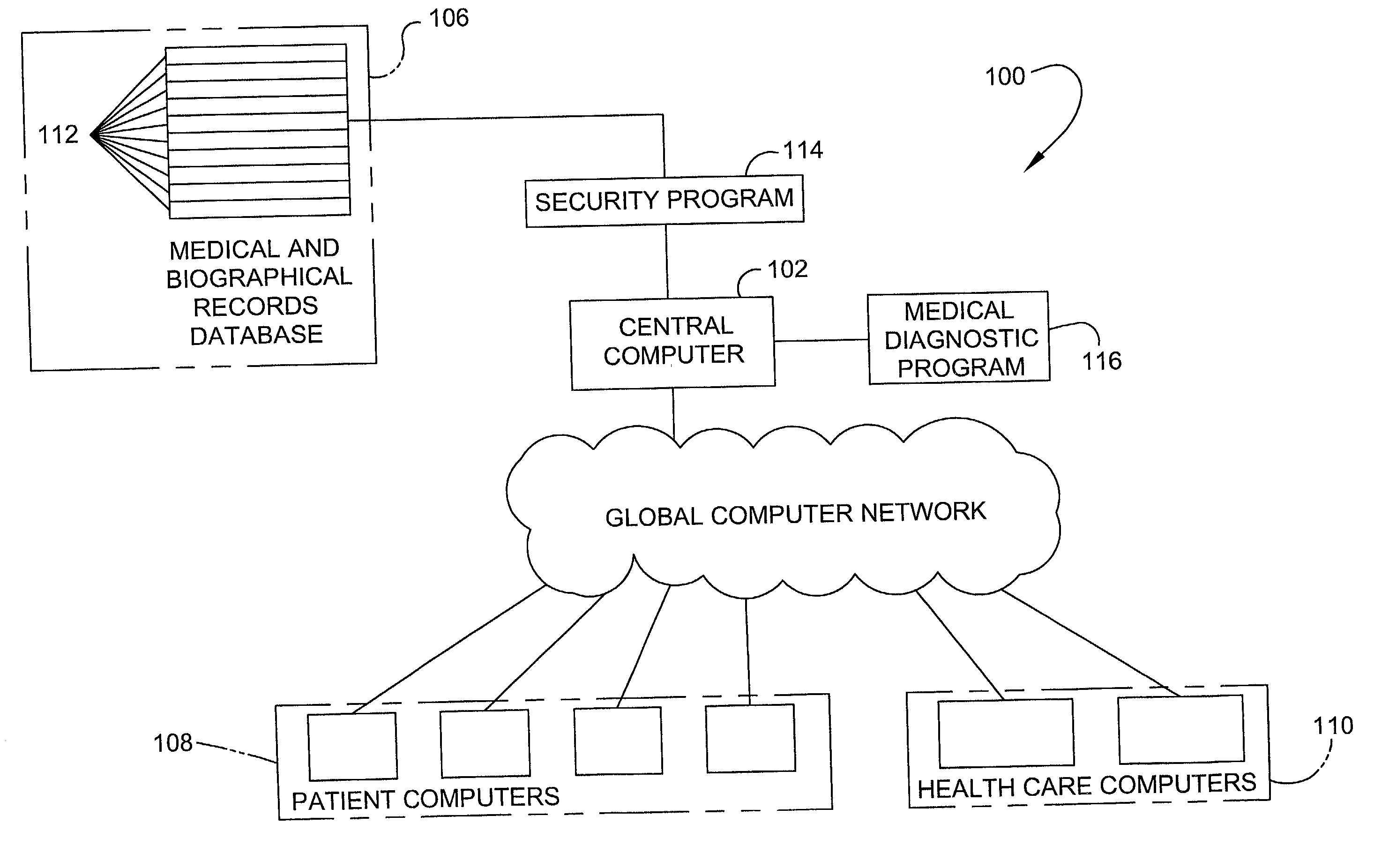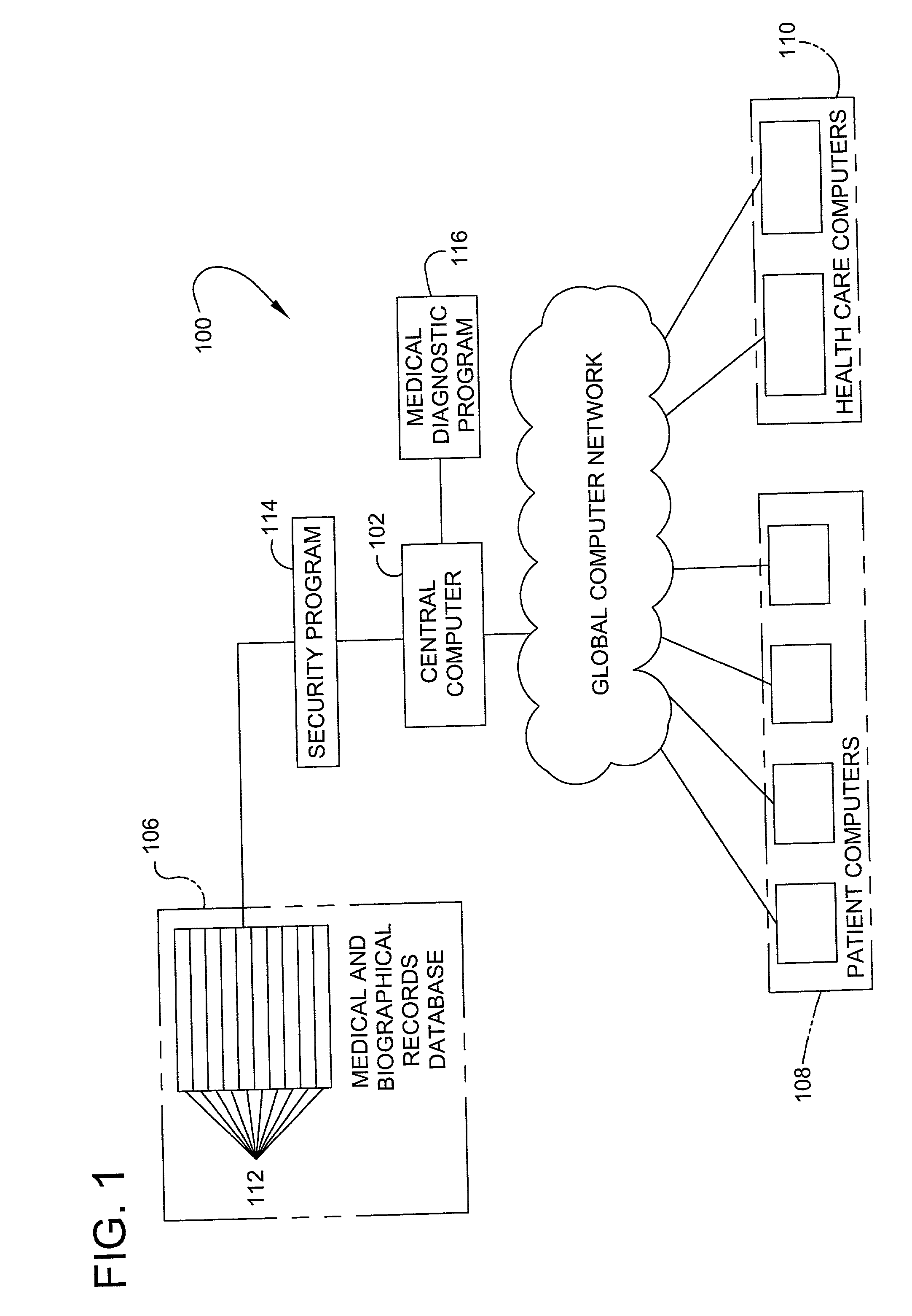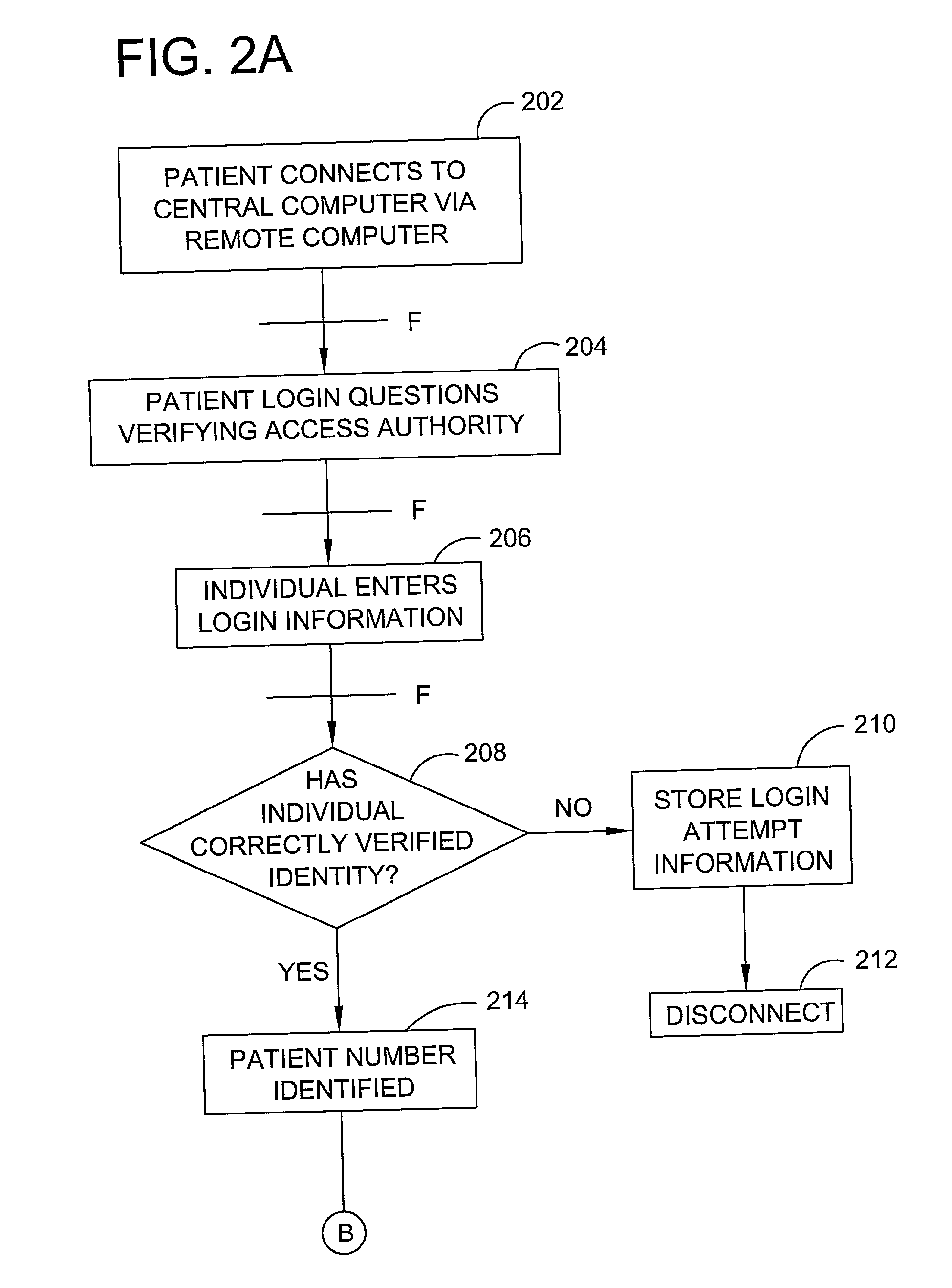Long term relationships and trust between a family doctor and patient are no longer commonplace because a change in
residence, job, or insurance carrier often requires the patient to change primary and / or
specialty health care providers.
Establishing relationships with a new health care provider can be tedious as medical records must first be transferred from previous health care providers and then reviewed by the new health care provider for
past history, therapies, and present therapeutic regimes.
Also, the new
medical record being created by the new health care provider is often incomplete as patients frequently fail to remember to include all the necessary medical or biographical information.
In fact, patients sometimes convey erroneous information that can be ultimately detrimental to their health.
Control of the information contained in a patient's medical and biographical record is also becoming a significant public issue and a source of controversy and stress.
Distrust on maintenance of
confidentiality results in failure to disclose information that may be important for health-care decisions.
This distrust may be increased as patients transfer to new health care providers.
While present automated systems may provide electronic storage of medical data, they typically suffer from significant shortcomings that have plagued
medical record systems since their inception.
These systems, like their paper record counterparts, are typically only available to health care professionals affiliated with the hospital, clinic, or other health care provider that owns the medical record
software program and computer system.
Thus, the information contained in a patient's medical record would not be able to be reviewed by another health care professional who is not affiliated with the health care provider that maintains the medical record software.
This becomes an issue for patients who choose to be treated by a different health care provider or who may require treatment while traveling in a location not served by their usual health care provider.
Similarly, health care professionals from different health care providers may not be able to easily review a patient's medical record and confer with each other as to diagnosis and treatment.
This may be due to either
security controls by the health care provider or by incompatible systems used by different health care professionals.
Thus, medical professionals wishing to confer with each other may be required to copy and mail or send a
facsimile of the patient's record, introducing privacy and control issues.
Additionally, a patient cannot prevent or control private information contained within the patient's medical record from being seen by any individual that has access to medical records, regardless of whether the individual has any right or need to review a particular portion of the patient's medical record.
As such, information which the patient wishes to remain private may be reviewed, thereby compromising the patient's privacy and potentially introducing a
negative bias to the health care professional towards the patient.
Current
medical systems also often do not contain useful data such as family history, biographical data, genetic constitution or make-up, or other information that a patient may add to his or her medical record which could aid health care professionals in diagnosing the patient's condition or determine the best
medical treatment.
Moreover, presently available medical records systems are not suited for providing medical diagnoses.
While these advancements have resulted in improved success rates of
medical treatment, individuals often
delay seeking
medical attention due to fear of the unknown and the inconvenience of being referred to multiple physicians.
Further referrals may occur if the patient is referred to medical sub-specialties for further diagnosis and treatment resulting in additional patient cost, time, and inconvenience.
This
delay can cause a medical condition which could be easily treated early in its development to require longer treatment or the condition may even become untreatable by the time medical assistance is sought.
The amount of available information, however, can be overwhelming to an individual trying to determine the identification of his or her particular
health condition who is unfamiliar with researching
health information or who lacks a scientific background.
Most patients do not understand these terms and therefore cannot effectively use the programs.
Thus, the
diagnostic information provided by these programs does not inform individuals of their various conditions before they seek medical assistance.
Such presence often generates discomfort or uneasiness and may lead to confused, unconsciously withheld, consciously suppressed information (e.g., suppressed for fear of embarrassment) or miscommunicated medical and biographical information.
Thus, patients may authorize or deny access to their medical and biographical records or limit access to only portions of their medical record to specific health care professionals thereby controlling privacy of the patient and
confidentiality of the patient's medical and biographical information.
The execution of a security program also limits access to the medical and biographical records
database to the individual patients retrieving medical and biographical information from their own records and to individuals selectively authorized by the patients.
The task is complicated because of the difficulty in obtaining, maintaining, and correlating the information as well as providing security measures to protect access to the information.
With the extensive and rapidly increasing pharmaceutical armamentarium available today, it has become difficult for health care providers and patients to be aware of all the drugs taken in the past and the present, as well as their generic equivalents, interactions, and side effects.
This is further compounded by the increasing inclusion of over-the-counter drugs, herbal treatments, and the like that many patients intake regularly but do not consider as part of their "medicines" and therefore
neglect to inform their health care providers that they are taking such substances.
As is well known, even the most interested and compulsive of people lack the discipline and perseverance to maintain a record of their lives.
This additional step circumvents the possibility of unauthorized access to the files of the medical and biographical records database if it is inadvertently left open by the health care provider.
Health care providers may be charged for the service of transferring patients' recorded medical histories to its own records thereby generating service and access fees.
Treatment and testing redundancy occurs frequently in the present
medical care environment due to the absence of a common repository of information and it ready availability.
Any health care professional with multiple denial events could lose the privilege to participate in the program.
Single or multiple violations may escape detection; patterns of abuse may eventually become evident, however, by comparing deviations from patterns of other health care professionals.
Due to the explosive growth of medications, alternative brands, and generics, there is a real risk that even the best informed and intentioned of health care professionals may miss an unintended interaction or secondary effect of a medication added to other medications already in use or to an underlying condition.
Of course, a
single patient request would be difficult to disguise, but the assumption is made that multiple charts would be requested by any one reviewer, diminishing significantly the chance of individual identification.
If the treatment is not within the covered policy, however, a rejection to the claim is made.
This method results in a qualitative approval or rejection of a claim being output by the computer rather than an individual looking at a patient's medical and biographical data which the patient desires to remain private.
The current system of financing health care is inefficient, expensive, inequitable, and complex.
One of the areas of difficulty in the present health care system is the
verification of services rendered and reasonable financing of the services.
Finding a formula that can be equitable to the insured patient through satisfying medical, emotional, sociologic and psychological needs and desires, health care providers (e.g., physicians, hospitals, etc.), employers, and the insurance industry, has not been solved.
Multiple approaches have been tried during the last century but have fallen short of balancing the needs of the interested parties.
As a result, a multitude of systems now exists that is becoming less functional and on the verge of collapse.
Areas of difficulty in the present health care system are the
verification of health care services rendered and reasonable financing of the services.
As a result, a multitude of failing systems exist.
Economics is perhaps the most difficult and perhaps also the biggest incentive to participate in this system.
At the present and foreseeable rate, health care expenses represent an enormous drain on any company.
Worst of all, the present
system of care is devoid of the necessary incentives to stimulate the individual to actively engage in preventive rather than therapeutic care.
Creating a formula that encourages individuals towards prevention is not an easy task, as numerous failures have demonstrated in the past.
Reducing direct costs can only be achieved by shifting part of the financial responsibility to the individual; this represents a reversal of the past 40 year trend and a difficult sell job unless substantial benefits to the individual can be added to the equation to sway the balance.
 Login to View More
Login to View More  Login to View More
Login to View More 


